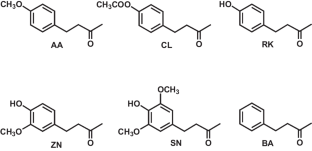Journal of Chemical Ecology ( IF 2.3 ) Pub Date : 2024-04-22 , DOI: 10.1007/s10886-024-01499-6 Keng Hong Tan , Ritsuo Nishida

|
The natural occurrence, distribution (within a plant) and roles of four phenylbutanoid compounds (anisyl acetone, cue-lure, raspberry ketone and zingerone) are elucidated for the Asia-Pacific and Oceania regions. These phenylbutanoids may act individually or in combination to attract true fruit fly males belonging to a tribe Dacini of subfamily Dacinae (Diptera: Tepritidae). Of special interest are the mutualistic interactions between the Dacini fruit fly males and the tropical daciniphilous (attracting exclusively Dacini fruit flies) orchids – leading to cross pollination for the orchids and enchanced mating success for the flies. When offered to male flies, anisyl acetone and cue-lure are generally converted to raspberry ketone. Upon consumption, raspberry ketone and zingerone are individually sequestered in the male rectal (pheromonal) gland unchanged. Attracted male flies readily imbibe the phenylbutanoid(s) in the floral synomone to compliment the endogenously synthesized male sex pheromonal components – to enhance attraction of conspecific females during courtship as well as attract conspecific males to form ‘leks’. The phenylbutanoid(s) may also act as an allomone to deter vertebrate predators, especially geckos, besides possessing antimicrobial and antioxidant activities. Cue-lure, raspberry ketone and zingerone are important attractants/lures used in pest surveillance and mass trapping under the integrated pest management (IPM) program against quarantine Dacini fruit fly pest species, particularly Bactrocera tryoni and Zeugodacus cucurbitae.
中文翻译:

天然苯基丁烷类引诱剂综述:自然界中的发生、分布和作用,特别是与达西尼果蝇行为和授粉有关
阐明了亚太和大洋洲地区四种苯基丁烷化合物(大茴香丙酮、诱饵、覆盆子酮和姜油酮)的自然存在、分布(在植物内)和作用。这些苯基丁烷类化合物可以单独或组合作用,以吸引属于 Dacinae 亚科 Dacini 部落(双翅目:Tepritidae)的真正雄性果蝇。特别令人感兴趣的是雄性达西尼果蝇和热带嗜达西尼果蝇(专门吸引达西尼果蝇)兰花之间的互利相互作用,从而导致兰花异花授粉并提高果蝇的交配成功率。当提供给雄性苍蝇时,茴香基丙酮和提示诱饵通常会转化为覆盆子酮。食用后,覆盆子酮和姜油酮分别以不变的方式隔离在男性直肠(信息素)腺中。受吸引的雄性果蝇很容易吸收花香素中的苯基丁烷类化合物,以补充内源合成的雄性性信息素成分,从而增强求爱过程中同种雌性的吸引力,并吸引同种雄性形成“leks”。除了具有抗菌和抗氧化活性之外,苯基丁烷类化合物还可以充当异激素来阻止脊椎动物捕食者,尤其是壁虎。提示诱剂、覆盆子酮和姜油酮是重要的引诱剂/诱剂,用于害虫综合管理 (IPM) 计划下针对检疫性达西尼果蝇害虫物种的害虫监测和大规模诱捕,特别是Bactrocera tryoni和Zeugodacus cucurbitae。



























 京公网安备 11010802027423号
京公网安备 11010802027423号